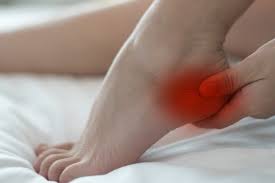
Heel pain is a common foot complaint that can significantly affect daily activities. It can occur due to various reasons, from injury to chronic conditions. This article will explore the potential causes, symptoms, and treatment options for heel pain.

Causes of Heel Pain
Heel pain can stem from several underlying issues, including:
1. Plantar Fasciitis
Plantar fasciitis is one of the most common causes of heel pain. It occurs when the plantar fascia, a thick band of tissue running along the bottom of your foot, becomes inflamed. This condition often leads to sharp, stabbing pain, especially when taking the first steps in the morning.
2. Heel Spurs
Heel spurs are calcium deposits that form on the underside of the heel bone. While they are often painless, they can cause discomfort when associated with conditions like plantar fasciitis.
3. Achilles Tendinitis
Achilles tendinitis is an overuse injury affecting the Achilles tendon, which connects the calf muscles to the heel bone. Repeated strain on this tendon can lead to inflammation, resulting in pain and stiffness at the back of the heel.
4. Bursitis
Heel bursitis occurs when the bursa (a small fluid-filled sac) at the back of the heel becomes inflamed. This condition is often caused by repetitive motion or pressure from tight footwear, leading to pain and swelling.
5. Stress Fractures
A stress fracture is a small crack in the heel bone, typically caused by repetitive stress or high-impact activities such as running or jumping. It can lead to sharp pain that worsens with physical activity.
6. Tarsal Tunnel Syndrome
Tarsal tunnel syndrome occurs when the tibial nerve is compressed as it passes through the tarsal tunnel near the ankle. This condition can cause pain, numbness, and tingling in the heel and foot.
Symptoms of Heel Pain
The symptoms of heel pain can vary depending on the underlying cause. Common symptoms include:
- Sharp or stabbing pain: Often felt in the bottom or back of the heel.
- Swelling: Around the heel area.
- Stiffness: Particularly after long periods of rest or in the morning.
- Redness and tenderness: Inflammation in the affected area.
- Difficulty walking: Severe pain can cause limping or difficulty with movement.
Diagnosis
To determine the cause of heel pain, a healthcare provider may ask about your medical history, perform a physical examination, and may also recommend imaging tests such as X-rays or MRIs. This will help rule out fractures, spurs, or other structural abnormalities.
Treatment Options for Heel Pain
1. Rest and Ice
The most basic treatment for heel pain is rest. Avoid activities that worsen the pain and apply ice to reduce swelling and inflammation. Elevating the heel can also help.
2. Footwear Changes
Wearing supportive shoes with good arch support and cushioning can alleviate stress on the heel. Avoiding high heels or flat shoes with poor support is crucial.
3. Orthotics
Custom orthotic inserts can provide additional support and redistribute pressure to reduce heel pain. Over-the-counter inserts may also be helpful.
4. Stretching Exercises
Regular stretching of the calf muscles, Achilles tendon, and plantar fascia can reduce tension and prevent pain. Exercises like calf raises and toe stretches are commonly recommended.
5. Medications
Nonsteroidal anti-inflammatory drugs (NSAIDs) like ibuprofen or naproxen can help reduce pain and inflammation. For more severe cases, corticosteroid injections may be recommended by a doctor.
6. Physical Therapy
A physical therapist can design a tailored program of exercises and treatments like ultrasound or massage therapy to alleviate it and promote healing.
7. Surgery
In rare cases, when conservative treatments fail, surgery may be necessary to correct the underlying cause of the heel pain, such as removing a heel spur or repairing the plantar fascia.
Prevention
To prevent heel pain, consider the following tips:
- Wear supportive footwear: Choose shoes with good arch support and cushioning.
- Warm up before exercise: Stretch your calves and feet before physical activity to prevent injury.
- Maintain a healthy weight: Excess body weight can put extra stress on your feet.
- Avoid overuse: Gradually increase the intensity of physical activities to avoid stress injuries.
When to See a Doctor
If you experience persistent it that does not improve with rest or home treatments, or if the pain is severe enough to interfere with daily activities, it’s time to consult a healthcare professional. Early diagnosis and treatment can prevent further complications.
Conclusion
It can range from a minor annoyance to a debilitating condition. Understanding the causes and seeking appropriate treatment is essential to finding relief. Whether it’s through rest, lifestyle changes, or medical intervention, addressing it early can help you get back on your feet faster and prevent future issues.